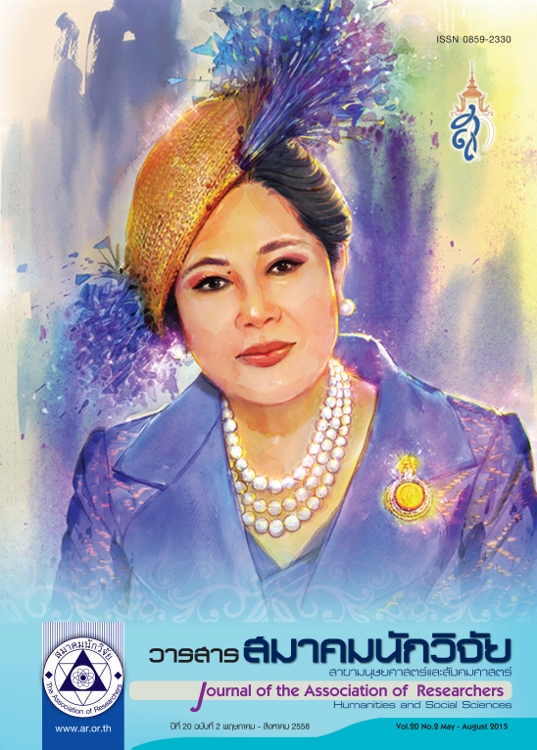Causal Factors of Socially Responsible Leadership Influencing to Corporate Image of Suvarnabhumi Airport
Main Article Content
Abstract
The objectives of this research were 1) to study the relationship among socially responsible leadership, stakeholders’ perception of corporate social responsibility and corporate image of Suvanabhumi Airport, 2) to study the influence of socially responsible leadership on corporate image of Suvanabhumi Airport, and 3) to study the influence of socially responsible leader and stakeholders’ perception of corporate social responsibility on corporate image of Suvanabhumi
Airport. Sample was Suvanabhumi Airport’s stakeholders. Quota and judgmental sampling was applied, and completely sample size was 400. The results found that correlation coefficient among observable variables were 0.426-0.674
and had a significant level at every variables. From structural equation modeling found that socially responsible leadership had influence on stakeholders’ perception of corporate social responsibility with significantly and the variance predicted by socially responsible leadership with 49.7 percent. Moreover, socially responsible leadership had influence on corporate image with significantly and had indirect effect via stakeholders’ perception of corporate social responsibility with significantly and variance predicted by socially responsible leadership with 66.0 percent. Finally, stakeholders’ perception of corporate social responsibility had direct effect to corporate image with significantly. Fit indices of the model were χ2/df = 4.348; CFI = 0.985; NNFI = 0.978; RMSEA = 0.092 และ 90% CI for RMSEA = 0.075
Article Details
บทความที่ปรากฏในวารสารนี้ เป็นความรับผิดชอบของผู้เขียน ซึ่งสมาคมนักวิจัยไม่จำเป็นต้องเห็นด้วยเสมอไป การนำเสนอผลงานวิจัยและบทความในวารสารนี้ไปเผยแพร่สามารถกระทำได้ โดยระบุแหล่งอ้างอิงจาก "วารสารสมาคมนักวิจัย"
References
พิพัฒน์ นนทนาธรณ์. 2553. การจัดการความรับผิดชอบต่อสังคมขององค์กร: การสร้างข้อได้เปรียบในการแข่งขัน อย่างยั่งยืน. นนทบุรี: ธิงค์บียอนด์.
_____2555. การจัดการจริยธรรมธุรกิจ: ฐานรากของซีเอสอาร์. กรุงเทพฯ: ศูนย์ผู้นำธุรกิจเพื่อสังคม.
_____2556. ภาวะผู้นำเชิงปฏิบัติการ: LIFE Model. กรุงเทพฯ: ศูนย์ผู้นำธุรกิจเพื่อสังคม.
_____2558. ภาวะผู้นำเชิงปฏิบัติการ: LIFE Model. (พิมพ์ครั้งที่ 2). กรุงเทพฯ: ศูนย์ผู้นำธุรกิจเพื่อสังคม.
รายงานความรับผิดชอบต่อสังคม 2554. บริษัท ท่าอากาศยานไทย จำกัด (มหาชน).
รายงานความรับผิดชอบต่อสังคม 2555. บริษัท ท่าอากาศยานไทย จำกัด (มหาชน).
รายงานความรับผิดชอบต่อสังคม 2556. บริษัท ท่าอากาศยานไทย จำกัด (มหาชน).
รายงานความรับผิดชอบต่อสังคม 2557. บริษัท ท่าอากาศยานไทย จำกัด (มหาชน).
สุวิทย์ สุทธิจิระพันธ์. 2547. ท่าอากาศยานสุวรรณภูมิ ท่าอากาศยานที่ทันสมัยที่สุดแห่งใหม่ของโลก. วารสารเศรษฐกิจ และสังคม. มกราคม – กุมภาพันธ์.
Bangkok Post. 2005. New Bangkok Airport - Now Aiming For July 2006 Opening.
Carroll, Archie (Ed.). 1977. Managing Corporate Social Responsibility. Boston: Little, Brown and Company.
Carroll, Archie B. and Ann K. Buchholtz, 2006, Business and Society (6th ed.). USA: Thomson SouthWestern.
Cheney, G., & Vibbert, S. L. (1987). Corporate Discourse: Public relations and issue management.
In F. M. Jablin, L. L. Putnam, K. H. Roberts, & L. W. Porter (Eds.), Handbook of Organizational Communication: An Interdisciplinary Perspective. 165-194. Newbury Park, CA: Sage.
Diamantopoulos, A., & Siguaw, J. A. 2000. Introducing LISREL: A Guide for the Uninitiated. Thousand Oaks, CA: Sage.
Dutton, J. E., & Dukerich, J. M. (1991). Keeping an eye on the mirror: Image and identity in organizational adaptation. Academy of Management Journal, 34(3), 517-554.
Dutton, J., E., Dukerich, J. M., & Harquail, C. V. (1994). Organizational images and member identification. Administrative Science Quarterly, 39, 239-263.
Hooper, Daire, Joseph Coughlan & Michael R. Mullen. 2008. Structural Equation Modeling: Guidelines for Determining Model Fit. Electronic Journal of Business Research Methods, 6 (1), 53 – 60.
Kotler, Philip, and Nancy Lee. 2005. Corporate Social Responsibility. New Jersey: John Wiley & Sons.
_____2008. Social Marketing: Influencing Behaviors for Good (3rd d.). Los Angeles: Sage.
_____2009. Up and Out of Poverty: The Social Marketing Solution. Upper Saddle River: Wharton School.
Leech, N. L., Barrett, K. C., & Morgan, G. A. 2005. SPSS for Intermediate Statistics: Use and Interpretation (2nd ed.).
Mahwah, NJ: Lawrence Erlbaum Associates. Moffitt, M. A. (1994). Collapsing and integrating concepts of ‘public’ and ‘image’ into a new theory.
Public Relations Review, 20(2), 159-170. Pless, Nicola M. 2007. “Understanding Responsible Leadership: Role Identity and Motivational Drivers” Journal of Business Ethics, 74:437-456.
Porter, Michael E. and Mark R. Kramer. 2006. “Strategy & Society: The Link between Competitive Advantage and Corporate Social Responsibility.” Harvard Business Review. HBR.ORG. December.
____2011. “Creating Shared Value: How to reinvent capitalism- and unleash a wave of innovation and growth.” Harvard Business Review. HBR.ORG. January-February.
Waldman, David A. 2007. Best Practices in Leading at Strategic Levels: A Social Responsibility Perspective in Jay A. Conger and Ronald E. Riggio, (Eds), The Practice of Leadership, San Francisco: Jossey-Bass.


